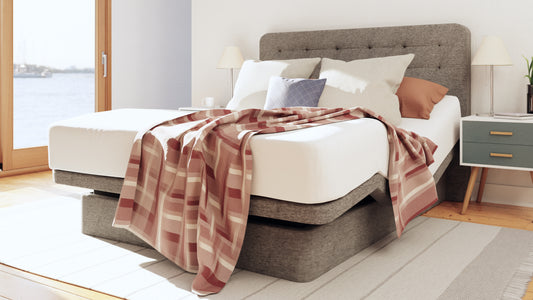According to the National Institutes of Health, 7% to 19% of adults do not get enough sleep, and 50-70 million American adults have chronic sleep disorders. Sleep disorders, like sleep apnea, insomnia, and restless leg syndrome, are hurting our quality of life—affecting our relationships, work performance, mental health, weight, and safety. And a staggering 95% of us admit to using electronics before bedtime. Is there a connection, or could it be a solution?
Countless studies have shown nighttime phone use can disrupt our sleep patterns, and blue light suppresses the production of melatonin that regulates our sleep. While conventional wisdom suggests avoiding technology in the bedroom, surprisingly, certain technology can promote better sleep health and improve sleep. Among the sleep-deprived, technology has its place. It can offer a stable routine, slumber-inducing apps, and high-tech innovations like smart mattresses and wearable trackers that promise to help us fall asleep, stay asleep throughout the night, and improve sleep quality.
Benefits of Technology in the Bedroom
We are so connected to our electronic devices, the internet, email, social media, and apps all day that we might think it would be nice to make our bedroom a tech-free sanctuary. But there are some uses where technology devices can simplify your life or even help you sleep better.
Instead of cluttering your bedside table, a cell phone can replace an alarm clock, a radio, a book, or a music player. We are long past the days when a phone is only used to make phone calls. A smartphone is a source of entertainment to unwind after a long day—chatting with friends, playing a game, or reading a new book. A laptop or tablet can be used to get in a few extra hours of work or homework. Having tech in the bedroom can improve your work efficiency if you prefer to jump on your workload late at night or in the early morning hours
Beyond the convenience, plenty of sleep technology apps can help improve your sleep health. Apps can help you avoid jet lag by adjusting your sleep schedule, guided meditation can gently ease you to sleep, and snore tracking can record your snoring and make recommendations for remedies to reduce your snoring.
New technology is evolving to help further improve your sleep in the future. New devices can tackle common sleep disorders, like wearable therapeutics to help with restless leg syndrome and chin sensors to detect sleep apnea. And for those who suffer from nightmares, especially due to PTSD, a new device intends to reduce sleep disturbances by monitoring heart rate and sleep motion and deploying a gentle vibration to provide immediate relief.
Cons of Technology in the Bedroom
Even with the best intentions of bettering your sleep, bringing technology into the bedroom can have a negative impact on you, your partner, or both. The American Academy of Sleep Medicine recommends turning off electronic devices at least 30-60 minutes before bedtime. Studies have shown a link between sleep loss and the effects of screen time. Blue light, which emits from the screen of your electronic devices, like a phone or iPad, has been found to suppress melatonin and trick your body’s biological clock into a level of daytime alertness.
While sleep trackers are useful for becoming more aware of our sleep patterns, there are limits to what they can tell you. And in some cases, they have the unintended effect of worsening insomnia due to the anxiety of focusing excessively on improving your data instead of your sleep quality. Researchers have even coined a term for those obsessed with perfecting their sleep data—orthosomnia. To avoid this preoccupation, focus on how you feel in the morning before checking your wearable device’s data. And use this data to support a conversation with your doctor.
By simply tracking your sleep, you are not fixing it. You need to put in the work to improve your healthy sleeping habits and dedicate enough time to get a good night’s sleep every night. Behaviors like setting a consistent sleep schedule, getting out of bed if you don’t fall asleep after 20 minutes, and establishing a relaxing bedtime routine, can help you avoid the dreaded daytime sleepiness. Sleep technology can help reinforce these good habits and keep you honest, but it is not a quick fix.

Image credit: KampusProduction-pexels
Types of Technology for Better Sleep
Numerous products are available and quickly growing that are designed to improve sleep. Technological devices help to optimize your sleeping environment by regulating light, noise, and temperature that can affect your sleep and even treat snoring and sleep apnea.
Block Blue Light. Many scientists have found that blue light emitted from your cell phone or tablet can contribute to sleep deprivation by disrupting your circadian rhythms. Most of these devices have a night mode function that shifts the display colors to be warmer, boosting your body’s ability to fall asleep. Also, consider blue light-blocking glasses to reduce light exposure and prevent side effects in your sleep cycle.
White Noise. White noise can be conducive to good sleep by blocking disruptive background noises or creating a blanket of sounds that eliminates silence but still helps you to relax. Your cell phone, tablet, smart speaker, or other devices can play white noise while you wind down and fall asleep. You can be lulled to bed by the sounds of gentle rainfall, ambient music, or the sounds of nature. There are many options available, and you can rotate as often as you would like.
Maintain Sleep Schedules. A smart clock can support establishing and maintaining a consistent sleep schedule. You can fall asleep faster with integrated breathing and sleep exercises or ease your wake-up with light that mimics the sunrise. And features can be controlled via app or smart home technology. The Dawn House bed offers a Rest and Unwind setting that adjusts the bed to the position that most easily prepares you for sleep.
Temperature Controls. It is difficult to get a sound sleep if you are tossing and turning because you are either too hot or too cold. Smart thermostats can help you regulate the temperature in your home to the perfect sleeping temperature. And an added benefit is you can save money by remotely controlling the home’s cooling and heating system to reduce energy consumption. That savings might help you sleep better too!
Interior Light Brightness. To set the mood for sleep, smart bulbs can emit soothing light when you need to wind down in the evening and induce sleep. And in contrast, in the morning, a brighter white light can energize you when it is time to wake up and get moving.
Tracking Sleep. Your fitness tracker or an app, like the Dawn House app, can monitor and track your sleep and other health patterns, giving you better insight into your sleep quality, duration, and stages of sleep. This information can be shared with your doctor to determine if you could benefit from more advanced sleep therapies.
What is a Smart Bed?
The term smart bed is used when a sleep system incorporates sensors and other technologies into the bed to monitor your sleep, or other health metrics. The sensors can adjust the temperature of your bed to achieve the perfect temperature for you. It can also gather data such as your heart rate, breathing rate, and duration of your sleep to provide information to focus on that is personal.
To get a better quality of sleep, most smart beds include these helpful features:
Sleep Tracking. The primary difference between a smart bed and a regular mattress is the smart bed will monitor your movements throughout the night while you sleep. Sensors throughout the bed will track heart rate, sleep restfulness, breathing rate, pressure, and even snoring.
Temperature Control. Do you wake up cold and steal your partner’s blanket? Or are you too hot and uncomfortable? Smart mattresses can regulate bed temperatures and even dynamically warm or cool the bed to your preference.
Air Chambers. Inflated air tubes inside the mattress include pressure sensors that allow the tubes to inflate (for firmness) or deflate (for a softer feel) to adjust to your body posture. The air tubes can also be remotely controlled with the bed app, giving you customization and personalized comfort.
App Integration. Most smart beds come with mobile apps that deliver data about your sleep straight to your smartphone. Some smart beds connect to your smart home host of items, from thermostats and smart lights to your coffee maker and TV. You can control and communicate with these different devices without leaving the bed.
Position Control. Use an app or a remote to adjust your smart bed. Position controls physically move the head or foot of the bed. If you have a split king bed you and your partner can individually move the bed to the position that is exactly right and comfortable for each sleeper.
Technology can find a place in your bedroom if appropriately used. Sleep technology, smart beds, and apps can help you optimize your sleep cycles so you can get the quality night of ZZs that you deserve. At Dawn House, we have developed a dynamic bed system that is comfortable and intuitive to support adults who seek to stay in their homes for as long as possible. Our smart adjustable bed offers head and foot articulation, bed height adjustment, and a rise-to-wake feature that automatically lifts your head to replace your jarring alarm clock. Health sensors in the sleep system passively monitor your vital health indicators and the health of your sleep cycle. Motion-activated underbed lighting will safely guide the way in low light. And you can control your bed with an ergonomic remote control, a dedicated Dawn House app, or simple voice commands. Dawn House bed features integrate seamlessly into your bedtime routine, and sleep, without disruption, leading to a better night’s sleep. With a Dawn House bed system, these features and others allow individuals to maintain their independence and mobility with stylish design to get a good night’s sleep.
Featured image credit: AndreaPiacquadio-pexels


